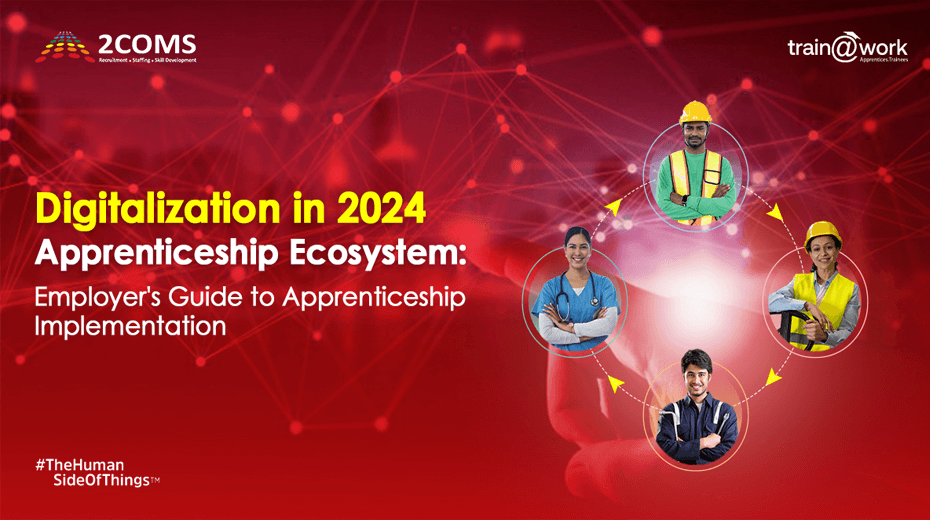As we move further into 2024, the landscape of apprenticeships is evolving rapidly, driven by digitalization and the need for skilled labor in an increasingly competitive market.
This article aims to provide employers with insights, facts, figures, and actionable pointers for effectively implementing apprenticeship programs in this new digital era.
Why Should Apprenticeships Be Digitalized?
Globally, there is an increase in the demand for expert labour; however, the skills gap is also expanding. Of the Indian workforce, only 10% received formal vocational training, according to India's Ministry of Skill Development and Entrepreneurship (MSDE). Despite their effectiveness, conventional apprenticeship models face limitations due to geographical restrictions, high administrative costs, and restrictive training structures. Digital apprenticeships provide scalable, flexible, and efficient solutions that address these challenges for both employers and apprentices.
Key Benefits of Digital Apprenticeships
- Enhanced Learning Experience: Digital tools enable apprentices to access a wealth of resources, including online courses, webinars, and virtual simulations. A report from the World Economic Forum indicates that digital learning can increase knowledge retention by 25-60%.
- Flexible Training Options: Employers can offer hybrid models that combine in-person training with online modules, accommodating diverse learning styles and schedules. This flexibility is crucial for attracting a younger workforce accustomed to digital environments.
- Data-Driven Insights: Digital platforms provide analytics that help employers track apprentices’ progress, identify skill gaps, and tailor training programs accordingly. Companies utilizing data analytics in their apprenticeship programs reported a 20% increase in overall performance.
- Broader Reach: Companies may recruit competent and diverse apprentices from different regions by accessing a global talent pool.
- Cost-effectiveness: Lower expenses for administrative and physical infrastructure due to automation.
Digital Apprenticeships in India: A Quick Overview
India's young population offers a priceless chance to develop a workforce prepared for the future. The National Apprenticeship Promotion Scheme (NAPS) has accelerated the uptake of apprenticeships, with more than 0.5 million apprentices working in various industries. The government wants to expand apprenticeship opportunities through programs like Atmanirbhar Bharat and Skill India.
The apprenticeship ecosystem in India will progressively use digital tools in 2024, including cloud-based training platforms, learning management systems (LMS), and artificial intelligence (AI) in talent screening. In their apprenticeship programs, more than 30% of Indian enterprises currently use digital technologies, a percentage that is predicted to increase as digitization initiatives across industries pick up speed.
Implementing a Digital Apprenticeship Program
Step 1: Define Clear ObjectivesEstablish what you aim to achieve with your apprenticeship program. Are you looking to fill specific skill gaps, enhance employee retention, or foster innovation? Clear objectives will guide your program's design and implementation.
Step 2: Leverage TechnologyUtilize Learning Management Systems (LMS) to deliver training content, track progress, and facilitate communication between apprentices and mentors. Popular LMS options include Moodle and TalentLMS, which can accommodate various learning formats.
Step 3: Collaborate with Educational InstitutionsPartnering with universities, community colleges, or vocational schools can enhance your apprenticeship program. These institutions can provide academic support and help develop a curriculum that aligns with industry needs.
Step 4: Foster a Supportive CultureCreate an environment where apprentices feel valued and supported. Regular feedback, mentorship opportunities, and recognition of achievements can significantly boost morale and motivation.
Step 5: Evaluate and AdaptRegularly assess the effectiveness of your apprenticeship program. Gather feedback from apprentices and mentors, analyze performance data, and be willing to make adjustments to improve outcomes.
Facts and Figures to Consider
- Investment in Digital Tools: A study by McKinsey found that companies investing in digital training saw a 30% increase in employee engagement and productivity.
- Apprenticeship Completion Rates: The National Apprenticeship Act reports that 80% of apprentices complete their programs, compared to only 50% of traditional training programs.
- Future Workforce Needs: The World Economic Forum estimates that by 2025, 85 million jobs may go unfilled due to the skills gap, underscoring the need for effective apprenticeship programs.
Case Studies: Digital Apprenticeships in Action
Case Study 1: Tata Consultancy Services (TCS)TCS, a prominent Indian IT company, has incorporated digital apprenticeships into its National Employability Enhancement Mission (NEEM), which has provided training to thousands of apprentices. TCS employs AI-based assessments and virtual laboratories to give the apprentices real-time feedback while they learn cutting-edge technologies such as cloud computing and AI.
Case Study 2: Siemens IndiaSiemens India has implemented a hybrid apprenticeship model that includes online courses for theoretical instruction and hands-on practice at Siemens facilities. This has resulted in a 30% reduction in training costs and increased skill retention for apprentices, as they receive continuous mentorship and feedback through their digital platforms.
Conclusion
As digitalization reshapes the apprenticeship ecosystem, employers must adapt their strategies to harness the full potential of these programs. By leveraging technology, fostering collaboration, and creating a supportive culture, businesses can not only bridge the skills gap but also cultivate a workforce that is prepared for the challenges of the future.
Call to Action
Are you ready to transform your apprenticeship program for the digital age? Share your thoughts and experiences in the comments below, and let’s discuss how we can collectively enhance the apprenticeship landscape in 2024 and beyond!
Visit our website for more details on Apprenticeship Project : https://www.2coms.com/





























